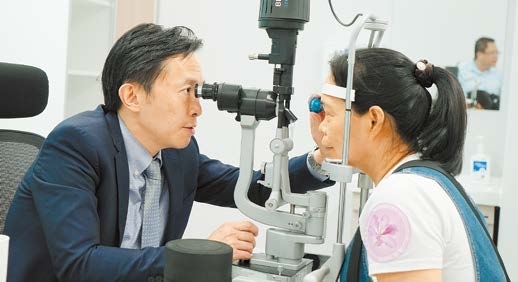
Debra Li debra_lidan@163.com TO promote eye care awareness among the general public, particularly senior citizens, Jeffrey Pong, an ophthalmologist from Hong Kong, gave a lecture to more than 200 residents from Hong Kong and Shenzhen’s Luohu District at the Shenzhen Bright Star Eye Hospital on Friday morning, marking the 30th National Sight Day in China. The most common eye diseases associated with aging are cataracts, macular degeneration, and glaucoma, according to Pong, consultant at Hong Kong Adventist Hospital and fellow of the Royal College of Surgeons of Edinburgh. Cataracts, a clouding of the lens of the eye, typically affect those aged 50 and above, causing blurred vision, hazy vision, and less vivid colors. Many people with cataracts can manage vision changes with eyeglasses and no surgery. However, as symptoms develop over time, doctors may recommend surgery when cataracts begin to interfere with daily activities such as driving and reading. Most patients undergo surgery in their 70s, which is the safest and most effective treatment for cataracts. Eye drops cannot cure the disease, Pong warned. The surgery, an outpatient procedure, usually takes 10 to 20 minutes to complete. The most common method is phacoemulsification, which involves the doctor making a very small incision in the eye and then using a tiny probe that produces ultrasound energy to dissolve the cataract. Another tool removes the cataract with suction. Nowadays, a laser is often used instead of a scalpel to make more precise incisions. Afterwards, the doctor places an intraocular lens (IOL) in the empty lens capsule. There are many types of IOLs available, and not every type is fully covered by insurance. Monofocal lenses correct one type of vision. Typically, people with monofocal lenses have them set for distance vision and use glasses for reading. Multifocal lenses have different zones built in for both near and distant vision. The most advanced accommodative lenses respond to eye muscle movement, allowing a shift in focus between near and distant vision. The best dietary sources of zeaxanthin are spinach and kale, which are both packed with substantial amounts of lutein and zeaxanthin. For animal-based options, egg yolks stand out as one of the top choices. Yellow and orange fruits like mangoes, oranges, and papayas are also rich in zeaxanthin. Pong will co-direct Shenzhen Bright Star Eye Hospital’s international clinic with Zhong Jingxiang, vice president of the First Affiliated Hospital of Jinan University. The hospital is offering free eye exams and surgery discounts for seniors throughout the month. | 
